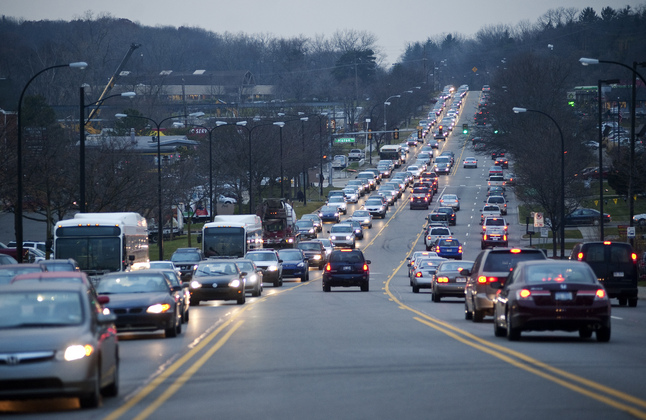
Traffic crowds Washtenaw Avenue Tuesday evening in Ypsilanti. The ReImagine Washtenaw initiative is trying to make the busy corridor friendlier to other modes of transit.
Daniel Brenner I AnnArbor.com
With four years of planning under the belt of the ReImagine Washtenaw initiative, a study is now in progress that could dictate the future configuration of 4.5 miles of Washtenaw Avenue from Stadium Boulevard in Ann Arbor to the water tower in Ypsilanti.
The goal of the initiative is to make the corridor friendly to all modes of transit, and to change the way businesses are built to make them more accessible to pedestrians.
Nathan Voght, project manager for ReImagine Washtenaw, said development change in connection with the initiative will likely begin with road improvements as the catalyst.
However, major changes to Washtenaw Avenue are likely more than five years away.
The vision
ReImagine Washtenaw is a multi-jurisdictional “placemaking” effort to make the corridor friendlier to buses, bicyclists and pedestrians. The stretch of Washtenaw Avenue from Ann Arbor to Ypsilanti has the highest housing density in the county, Voght said.
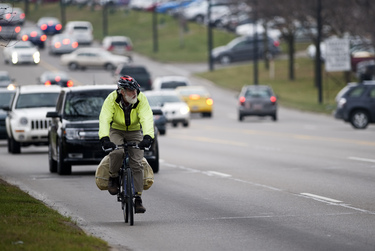
A bicyclist rides with traffic Tuesday on Washtenaw Avenue in Ann Arbor. ReImagine Washtenaw would add a bike lane or multi-use pathway to make it safer for people to bike in the corridor.
Daniel Brenner I AnnArbor.com
“We’re trying to go from a corridor that everyone endures and tolerates to one that they want to live on and enjoy,” Voght said.
Ann Arbor, Ypsilanti, Ypsilanti Township, Pittsfield Township, the Ann Arbor Transportation Authority, the Michigan Department of Transportation and Washtenaw County have all been working together to seek public comment and find funding sources for the initiative. So far, they’ve been met with a positive reception.
A bill sponsored by Rep. Jeff Irwin, D-Ann Arbor, and Rep. Mark Ouimet, R-Scio Township, was signed into law at the end of June that will allow the creation of a Corridor Improvement Authority for Washtenaw Avenue.
The authority could divert some property taxes in the district to fund specific improvements in the corridor. However, no conversations to form such an authority are under way, Voght said.
The new Arbor Hills Development project — a 90,700-square-foot complex at Platt Road and Washtenaw Avenue — is a prime example of the kinds of commercial buildings ReImagine Washtenaw is working to promote. Workers broke ground on the project this year after it received full approval from the Ann Arbor City Council in late 2011.
Voght said there are certain intersections along Washtenaw Avenue that are more ripe for development than others: Golfside Road, Hewitt Road and Huron Parkway.
Many people ask Voght why ReImagine Washtenaw is even attempting to change the traffic-heavy route.
“That’s a really pessimistic view for the corridor. Why do we continue to make decisions and investments that don’t keep people safe?” Voght said. “Adding more lanes invites more traffic.”
The funding
Funding the improvements to the corridor will be the main challenge for the entire project.
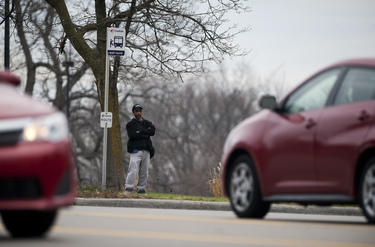
A pedestrian waits at a bus stop on Washtenaw Avenue in Ann Arbor on Tuesday.
Daniel Brenner I AnnArbor.com
AATA has received $2.6 million from the federal government for improvements related to the ReImagine Washtenaw project. The grant is to purchase clean diesel buses with hybrid-electric components to increase transit service frequency on Washtenaw Avenue — a corridor that sees about 1 million bus passengers per year, Voght said.
Washtenaw County also has some money in play, as the county’s Office of Community and Economic Development has received a $3 million grant from the U.S. Department of Housing and Urban Development. About half of a million of that grant has been allocated to ReImagine Washtenaw, Voght said.
About $250,000 of that allocation is being used for a right-of-way and transit stop design study, which launched in October and will end in summer 2013. The county has hired SmithGroupJJR and Parsons/Brinckerhoff for the work.
The survey will determine the traffic flow through major intersections in the corridor, as well as modeling to show how different configurations of bike lanes, sidewalks, bus lanes and mid-block crossings could affect traffic. The models will assume more people will be walking, biking and taking the bus in their travels in the corridor and that less people will be driving a vehicle.
The study conducted by transportation engineers will also provide designs of eight AATA “Super Stop” locations.
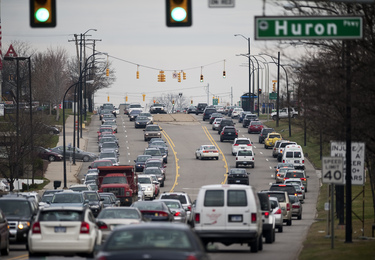
Traffic on Washtenaw Avenue near Huron Parkway in Ann Arbor on Tuesday.
Daniel Brenner I AnnArbor.com
“The more efficient and reliable you make public transit, the more riders you get,” Voght said.
Future traffic configurations will not make Washtenaw Avenue intersections less efficient than they are now, Voght said. The intent of the study is to generate an agreement that will be used to determine future decisions.
“We want to be able to hand everyone the plan that we all agreed to,” Voght said.
The right-of-way study will be completed by June. In March, several public meetings will be held to get comments on streetscape designs.
The other $250,000 is being used to hire consultants to revise master plan language and zoning ordinances for the townships of Pittsfield and Ypsilanti, which should be completed by June. The city of Ypsilanti’s master plan is being completely revised and will be overhauled in about 18 months, Voght said.
The master plans will be updated with progressive zoning language to stipulate for zero lot line development and buildings that are higher-density, mixed-use properties. Voght said the county has hired Pittsfield Township’s planning consultant to make sure the updates to all three master plans are in sync.
Ann Arbor’s master plan is up-to-date enough that it did not need to be re-worked, Voght said.
Public and private investment
With the updates to the zoning ordinances, Voght admitted that some businesses may be deterred from buying property or making updates to properties in the corridor.
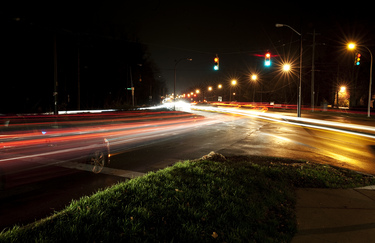
Cars stream through the intersection of Washtenaw Avenue and Stadium Boulevard Tuesday night in Ann Arbor. The intersection is the beginning of the area that ReImagine Washtenaw wants to improve.
Daniel Brenner I AnnArbor.com
“They don’t get that a more walkable neighborhood would get them more business,” Voght said.
The current auto-oriented configuration along Washtenaw Avenue limits commerce, Voght said.
“You can’t park in (a business’ parking lot) and get to more than two stores,” he said. “The challenge is, who’s the first guy that comes in and builds this?”
Businesses will be offered incentives to fit the model of development the ReImagine Washtenaw planners are seeking. The building process will be expedited for developers that conform to the zoning standards, Voght said.
Voght said he believes private businesses will be attracted to invest in the corridor after a public investment is made to change the streetscape of Washtenaw Avenue — which will take significant funds.
“Public investment begets private investment,” Voght said. “We prefer improvements be done right, and wait for sufficient funding to do it right.”
MDOT's role
Washtenaw Avenue, a state-owned roadway, is currently rated in good condition. The portion in Ann Arbor was last re-paved in 2008, and the section from US-23 east to Ypsilanti was last re-paved in 2009.
According to MDOT, there are no plans in the next five years to reconstruct the roadway.
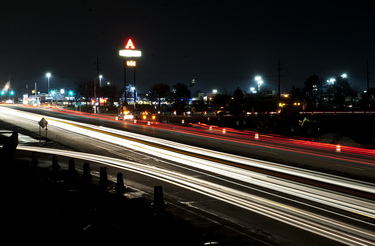
Cars leave streams of light Tuesday night on Washtenaw Avenue near Interstate 23 in Ann Arbor.
Daniel Brenner I AnnArbor.com
MDOT is currently in the midst of a $2.27 million construction project on Washtenaw Avenue at the US-23 interchange to add a mutli-use path on both sides of the road underneath the highway from Carpenter Road to Yost Boulevard.
MDOT typically makes its decisions on where it will re-construct roads based on pavement conditions, Martin said.
The department’s budget for 2012 to 2016 is set. Martin said the next version will be updated next year for 2013 to 2017.
MDOT’s complete streets initiative aligns well with ReImagine Washtenaw’s goals, Martin said.
“We’re trying to make roads for all users,” Martin said.
Martin said MDOT would consider the plan set forward by the ReImagine Washtenaw as along as operationally, it fits the needs of the road and if funding is available.
“At the end of the day, it’s (MDOT’s) road,” Voght said. “Some communities want the road back, but it’s not being talked about right now.”
Amy Biolchini covers Washtenaw County, health and environmental issues for AnnArbor.com. Reach her at (734) 623-2552, amybiolchini@annarbor.com or on Twitter.